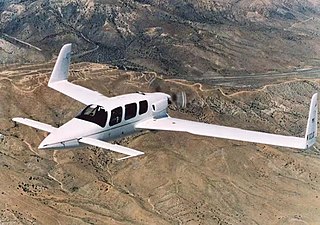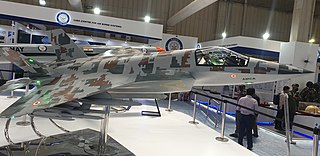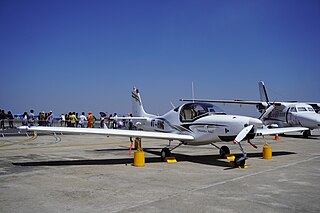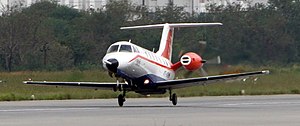
The HAL Tejas is an Indian single-engine, 4.5 generation delta wing multirole combat aircraft designed by the Aeronautical Development Agency (ADA) and manufactured by Hindustan Aeronautics Limited (HAL) for the Indian Air Force (IAF) and Indian Navy. Tejas made its first flight in 2001 and entered into service with the IAF in 2015. In 2003, the aircraft was officially named "Tejas". Currently Tejas is the smallest and lightest in its class of supersonic combat aircraft.

The AASI Jetcruzer was an American single turboprop light civil transport made by Advanced Aerodynamics and Structures Inc. The Jetcruzer had an unusual configuration, with a single turboprop engine driving a pusher propeller, a prominent canard, and fins mounted at the ends of its swept wings. The plane has seating for up to six people including the pilot. The Jetcruzer is noteworthy for being the first aircraft to have achieved a spin resistance certification from the United States FAA.

The Antonov An-32 is a turboprop twin-engined military transport aircraft. Its first flight was in July 1976 and displayed at the 1977 Paris Air Show. It is oriented towards flying in adverse weather conditions, and was produced from 1980 to 2012, and remains in service. It was developed from the An-24, and the An-26 is related.

The HAL HF-24 Marut was an Indian jet fighter aircraft developed and manufactured by Hindustan Aeronautics Limited (HAL) during the 1960s and early 70s. The Marut was designed by the German aeronautical engineer Kurt Tank, with the Project Engineer being George William Benjamin. The aircraft was the first Indian-developed jet fighter and the first in Asia, outside the Soviet Union, to go beyond the test phase and into serial production and active service. On 17 June 1961, the type conducted its maiden flight; on 1 April 1967, the first production Marut was officially delivered to the IAF.

The HAL HJT-36 Sitara is a subsonic intermediate jet trainer aircraft designed and developed by Aircraft Research and Design Centre (ARDC) and built by Hindustan Aeronautics Limited (HAL) for the Indian Air Force and the Indian Navy. The HJT-36 will replace the HAL HJT-16 Kiran as the Stage-2 trainer for the two forces.

The National Aerospace Laboratories (NAL) is India's first and largest aerospace research company established by the Council of Scientific and Industrial Research (CSIR) in Delhi in 1959. The company closely operates with HAL, DRDO, and ISRO and has the primary responsibility of developing civilian aircraft in India. It concentrates on research in advanced topics in aerospace and related disciplines.

The Advanced Medium Combat Aircraft (AMCA) is an Indian single-seat, twin-engine, all-weather fifth-generation stealth, multirole combat aircraft being developed for the Indian Air Force and the Indian Navy. The Mark-1 variant of the aircraft will be a fifth generation fighter while the Mark-2 variant will have sixth-generation technologies. The aircraft is designed by the Aeronautical Development Agency (ADA) - an aircraft design agency under MoD. A Special Purpose Vehicle (SPV) consisting of ADA, Hindustan Aeronautics Limited (HAL) and a private company is being formed for the development and production of AMCA. In March 2024, the project received approval from India's Cabinet Committee on Security for the prototype development.

The HAL Ajeet was a jet-powered fighter aircraft developed and manufactured by Indian aerospace manufacturer Hindustan Aeronautics Limited (HAL). It was operated by the Indian Air Force (IAF) between 1977 and 1991.

The Gulfstream G100, formerly known as the IAI Astra SPX, is an Israel Aerospace Industries-manufactured twin-engine business jet, that was produced for Gulfstream Aerospace. Deliveries began in 1986. The United States Navy employs the aircraft as the C-38A Courier. A later derivative known as the G150 was launched in 2002. Gulfstream announced the final sale of the G150 in September 2016 and the last delivery by mid-2017.

The GTRE GTX-35VS Kaveri is an afterburning turbofan project developed by the Gas Turbine Research Establishment (GTRE), a lab under the Defence Research and Development Organisation (DRDO) in Bengaluru, India. An Indian design, the Kaveri was originally intended to power production models of the HAL Tejas Light Combat Aircraft (LCA) developed by Hindustan Aeronautics Limited. However, the Kaveri programme failed to satisfy the necessary technical requirements or keep up with its envisaged timelines and was officially delinked from the Tejas programme in September 2008.

The HAL Prachand is an Indian multi-role light attack helicopter designed and manufactured by Hindustan Aeronautics Limited (HAL) under Project LCH. It has been ordered by the Indian Air Force (IAF) and the Indian Army. Its flight ceiling is the highest among all attack helicopters.

The NAL Hansa is an Indian all-composite low wing tricycle gear two-seater general aviation monoplane. It is the first indigenously produced composite aircraft in India.

The DRDO Nishant - is an unmanned aerial vehicle (UAV) developed by India's Aeronautical Development Establishment (ADE), a branch of Defence Research and Development Organisation (DRDO) for the Indian Armed Forces. The Nishant UAV is primarily tasked with intelligence gathering over enemy territory and also for reconnaissance, training, surveillance, target designation, artillery fire correction, damage assessment, ELINT and SIGINT. The UAV has an endurance of four hours and thirty minutes. Nishant has completed development phase and user trials.

The Cessna Citation V is a business jet built by Cessna that was in production from 1989 until 2011. During that time, 774 such craft were made. The first Model 560 prototype, a stretched version of the Citation S/II, flew in August 1987 and was certified on December 9, 1988.

The Grob G180 SPn is a low-wing twin-engined composite corporate jet designed and built by German aircraft manufacturer Grob Aerospace. Development was suspended during 2008 in response to the Grob's insolvency; since then, multiple efforts have been made to re-launch the programme. Tata Advanced Systems Limited (TASL) has bought the Intellectual Property rights of the aircraft and will manufacture it in India.
The Indian Air Force has been undergoing a modernization program to replace and upgrade outdated equipment since the late 1990s to meet modern standards. For that reason, it has started procuring and developing aircraft, weapons, associated technologies, and infrastructures. Some of these programs date back to the late 1980s. The primary focus of current modernization and upgrades is to replace aircraft purchased from the Soviet Union that currently form the backbone of the Air Force.

The HAL HTT-40 is an Indian training aircraft designed and built by Hindustan Aeronautics Limited (HAL). It will replace the Indian Air Force's retired HPT-32 Deepak as a basic trainer.

The Indian Air Force Test Pilot School is a unit of the Indian Air Force (IAF) that evaluates aircraft and systems for induction into user organisations. Most new aircraft types and major airborne systems must have ASTE's stamp of approval to be considered fit for service in India. While many countries have testing facilities of one kind or the other, training of flight test personnel is not often imparted in them. ASTE's Air Force Test Pilots School (AFTPS) is only the fifth such institution in the world.

The HAL Tejas Mark 2, or Medium Weight Fighter (MWF), is an Indian single-engine, canard delta wing, multirole combat aircraft designed by the Aeronautical Development Agency (ADA) in collaboration with Aircraft Research and Design Centre (ARDC) of Hindustan Aeronautics Limited (HAL) for the Indian Air Force (IAF). It is a further development of the HAL Tejas, with an elongated airframe, close coupled canards, new sensors, and a more powerful engine.

HF-73 also known as Hindustan Fighter-73 was a proposed twin engine strike fighter intended to be operated by the Indian Air Force. It was a joint venture project undertaken by India's Hindustan Aeronautics Limited and Messerschmitt-Bölkow-Blohm (MBB) of West Germany in 1972. The proposed HF-73 strike fighter was similar in design and role to the multi-national European consortium Panavia Aircraft GmbH's Panavia Tornado. The project was cancelled in the late 1970s.






















